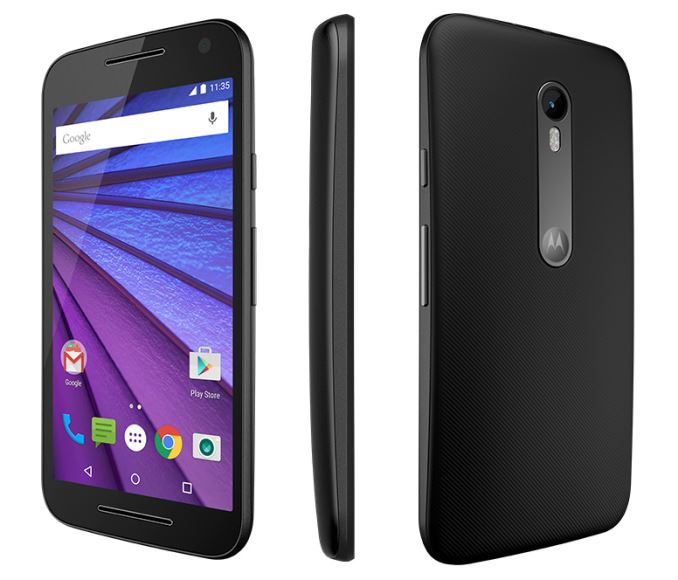Motorola Announces the New Moto G
by Joshua Ho on July 28, 2015 10:25 AM EST- Posted in
- Smartphones
- Qualcomm
- Motorola
- Mobile
- Moto G
- Snapdragon 410

Today, Motorola announced the successor to their Moto G, which has been their most successful phone in recent memory. It’s still called the Moto G, but this is the 2015 model which brings some long-needed updates to keep the Moto G fresh. These changes are far-reaching, and range from the SoC to the camera and design. In order to understand the new Moto G at a high level I’ve attached the specs below for those interested.
| Moto G (2014) | Moto G (2015) | |
| SoC | Snapdragon 400 1.2 GHZ A7 | Snapdragon 410 1.4 GHz A53 |
| RAM | 1GB | 1/2GB |
| NAND | 8GB NAND + microSD | 8/16GB NAND + microSD |
| Display | 5” 720p IPS |
5” 720p IPS |
| Network | 2G / 3G | 2G / 3G / 4G LTE (Category 4 LTE) |
| Dimensions | 141.5 x 70.7 x 11mm, 149g | 142.1 x 72.4 x 6.1-11.6mm, 155g |
| Camera | 8MP Rear Facing (Sony IMX179) f/2.4, 1.4 micron 1/3.06" sensor | 13MP Rear Facing (Sony IMX214) f/2.0, 1.1 micron 1/3.06" sensor |
| 2MP Front Facing | 5MP Front Facing | |
| Battery | 2070 mAh (7.87 Whr) | 2470 mAh (9.39 Whr) |
| OS | Android 4.4 (At Launch) | Android 5.1 (At Launch) |
| Connectivity | 2.4 GHz 802.11b/g/n + BT 4.0, USB2.0, GPS/GNSS |
2.4 GHz 802.11b/g/n + BT 4.0, USB2.0, GPS/GNSS |
| SIM | MicroSIM | MicroSIM |
| Launch Price | $179 (1GB/8GB) | $179 (1GB/8GB) $219 (2GB/16GB) |
Although specs are important, one of the most immediate changes to the Moto G this year is the new design. Instead of the all-plastic design that we were accustomed to with the previous two Moto Gs, the new Moto G has a new, grippier plastic back cover. The generally refreshed design helps a lot with distinguishing this model from previous years, and generally helps to increase the value proposition associated with the smartphone. Outside of design, there are a few key changes at a high level such as the camera, SoC, more RAM on the 16GB SKU, and water resistance. The battery is also bigger, at 2470 mAh compared to 2070 mAh of the last generation.
When it comes to the camera, it seems that this unit is directly shared with the Nexus 6’s camera, although it doesn’t seem to have the more expensive voice coil motor that is needed to enable OIS. There’s also a 5MP FFC, which should is a big step up from the 2MP FFC of the previous generation. The SoC moves from the Snapdragon 400 of previous generations to the Snapdragon 410, which means a move to the Cortex A53 on the CPU side. Given just how much higher the IPC is for the Cortex A53, general computing performance should improve here much like we saw with the Moto E moving to A53. The move from 1GB to 2GB of RAM is also a huge boon for multitasking performance, although this is only available on the more expensive 16GB variant. The 8GB variant will remain with 1 GB of RAM. The addition of IPx7 water resistance should also help greatly against water damage, as this means that the Moto G 2015 should be able to spend 30 minutes under a meter of still water without damage, although I still wouldn’t recommend trying to test that functionality.
The new Moto G is available online today from Motorola, Best Buy, and Amazon. The 8GB variant will start at 179.99 USD, and the 16GB variant will be available from Motorola’s website. The new Moto G will also support Motomaker, which allows for extensive color and material customization of a new smartphone.












52 Comments
View All Comments
tipoo - Tuesday, July 28, 2015 - link
The first gen one did not have MicroSD, the 4G refresh and the second gen did.GauravDas - Tuesday, July 28, 2015 - link
Yes, the first gen Moto G didn't have microSD. Second gen did.nwarawa - Tuesday, July 28, 2015 - link
Do not want.None of the new Motorola stuff I want. I got the 2013 Moto X, and I love it. 4.7" IPS 720P screen that not once have I felt I missed out on higher resolution. It came with 11ac and 2GB of RAM. I have close to 100 chrome tabs open and it still runs fine. My 2 year term is up on boxing day, 2015, and I was hoping the specs would have trickled down to the Moto G after 2 years... nope. They already have a Moto E with 8GB/1GB spec... why even offer that on the Moto G in 2015, now their mid range phone? And only 2.4GHz N Wifi on a midrange phone in this day in age? Give me a break. The 4.7" size was perfect. 5" is still doable, so that is why I was considering the Moto G as the replacement... but obviously that's out the window. My sister in law got the 2014 5.2" Moto X. I played around with it... already found that too big. Now they're trying to push 5.7" on me? And dropping the OLED for IPS? What about the active display that I loved so much? Screw you, Motorola... I love the Active display, the twist-for-camera I depend on now day-to-day, the always on voice recognition... but I'm not going to walk around with this 5.7" freak-show of a device bulging out of my pocket.
utmode - Tuesday, July 28, 2015 - link
Display is still 5 inch mate :)Impulses - Tuesday, July 28, 2015 - link
He's talking about both the X and G, nothing in his post is inaccurate. Reading the comments it seems him and I and many others are on the same damn boat... Moto X (2013) and even N5 owners that don't want 5.5"+ flagships but can't find anything else worth upgrading to.The difference between a phone measuring 130-135mm x 65-70mm (as the original X and small bezel N5 did) and a 5.5" flagship measuring 150mm+ x 75mm+ is pretty substantial in the hand and operationally.
I guess people with small hands might not care either way, and giants will obviously prefer larger. I'm 5'11" and I can just barely reach my notification shade with one hand without adjusting my grip, anything larger makes that impossible and begins to dig into my leg while in pocket when I sit, squat, etc (and no, I don't wear skinny jeans at all).
djvita - Tuesday, July 28, 2015 - link
upgrade to a xperia z3 compact. it runs faster than a nexus 5, its smaller than my razr hd, the chipset is still good, the camera is better than any nexus or motorola (until this gen)battery life is stellar
and its only $350 now!
Impulses - Tuesday, July 28, 2015 - link
Didn't realize it was down to $350, it's actually the only phone I've seriously considered getting over the last two years... Would have to change carriers for it tho. :/ That hassle (I'm generally satisfied with my carrier) plus lack of Qi stopped me. I really liked what I saw in it otherwise, it's basically the only mid size flagship in two years too.BMNify - Tuesday, July 28, 2015 - link
Till the time you remain Telecom carrier slave, you will keep facing such problems, this is a unique USA problem as rest of the world buys any phone and uses it on any network.Impulses - Tuesday, July 28, 2015 - link
Ehh, there's two sides to everything. My nexus 5 happens to work on three of the four major carriers, along with mostly every other GSM MVNO... So there's obviously ways to make phones that are more universal before the eventual LTE transition (which might or might not make things worse, in the US and abroad).I also pay like $60 a month for unlimited everything and I can travel from LA to NYC while using it, along with Hawaii and Puerto Rico (in the Caribbean, where I live). You might pay less, but how far can you go without roaming charges or switching numbers?
WorldWithoutMadness - Wednesday, July 29, 2015 - link
Although that is correct but you have to pay full price of that phone and mostly are more expensive than the unlocked version in the US. Another downside is you have to wait at least months to get it as well.